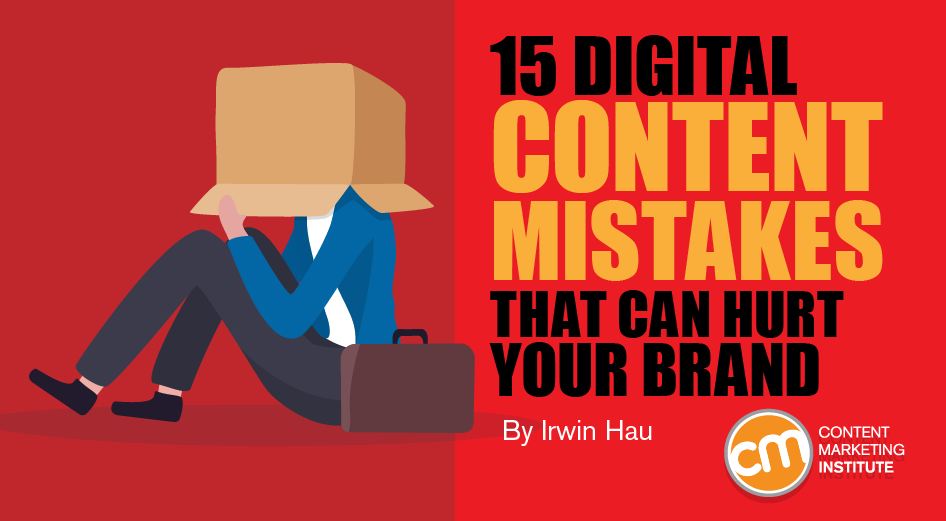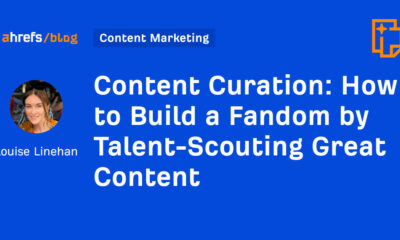MARKETING
15 Digital Content Mistakes That Can Hurt Your Brand

Just as content can help your brand, it can hurt it, too.
Publishing the wrong content can take many forms, but the end results are similar. At worst, it could seriously damage your brand. At best, your content will be ignored.
I’ve rounded up most of the biggest suspects when it comes to content that does more harm than good, so you can avoid them and only create content that really helps your brand.
1. Too much promotional content
Ever been stuck in a conversation with a serial bragger? Yawn.
People who go on about how great they are get boring fast – the same goes for brands. After all, your relationship with your customers should be about them, not you. If you ignore their needs, they’ll assume you’ve got nothing for them and head elsewhere.
The 80/20 rule has been cited as the effective social media content ratio. Focus 80% of your posts on informing and entertaining your followers, while just 20% should be about your business. Similarly, the five-three-two rule says for every 10 posts published, five should be curated from others’ content, three should be original to your brand, and two should be personal and fun to humanize your brand.
But do these rules still hold true? In general, yes. While the ratio may vary, always put your audience first when choosing what to publish.
Always put your audience first when choosing what to publish, says @IrwinHau via @CMIContent. #ContentMarketing Click To Tweet
TIP: Not sure if your brand is dominating the conversation? Review your past month of posts and identify how many are related to what’s important to your brand and how many are related to what’s important to your audience. (Some may address both audiences.) If the number for your brand is higher than for your audience, you’re talking too much about the brand.
2. Email inundation
Consider these two eye-opening statistics: 76% of customers expect consistent interaction with a brand regardless of department. Yet only 54% say it seems sales, service, and marketing teams are siloed and don’t share information.
That disconnect often shows up in the customers’ inboxes. For example, a promotional email is sent. Within minutes, a newsletter shows up in an inbox, followed two hours later with a feedback request from customer service.
That lack of cohesive distribution can prompt your audience to be frustrated with the quantity and disparate connection of your brand’s communication. They are likely to unsubscribe from all your brand’s emails – even the ones they found some value.
Work across silos to coordinate your email outreach with your audience. If that’s not feasible, update your “unsubscribe” form to give them choices on what content they would like to receive (and not receive.)
Word across silos to coordinate #email outreach with your audience so you don’t inundate them, says @IrwinHau via @CMIContent. #ContentMarketing Click To Tweet
HANDPICKED RELATED CONTENT:
3. Overly negative content
Doomscrolling is a thing, but it shouldn’t be something your brand leans into. Though negative content is shared more than positive content, the publisher of that negative content is not necessarily regarded more highly.
I don’t see talking about a customer’s pain points as the same as negative content. If you offer a solution, that’s good marketing. But if you start and end on a negative note, your brand is just being a downer.
4. Talk about potentially controversial topics
Since the 1800s, some form of the saying, “Never discuss politics or religion in polite company,” has been around. And the same holds true for brands when talking to their audiences.
Bring up highly polarizing and emotional topics only if they are part of your brand’s mission and approach to business. If they are, do so in a measured and well-researched way.
5. Bad writing and design
If your words are riddled with poor grammar, your message won’t sit right and may not even be understood. The same goes for poor design of your content. Good writing and design have the power to build your brand’s personality, weave stories, and inspire.
6. Inconsistent voice
Along with bad copy and bad design, content that seems to have a personality crisis is another major turnoff.
#Content that seems to have a personality crisis is another major turnoff, says @IrwinHau via @CMIContent. #ContentMarketing Click To Tweet
One minute, your brand posts cat memes related to your topic. The next post is a deep think piece. You end up with a puzzled audience who don’t have a clue as to what your brand’s voice is.
Always keep your brand voice and style in mind as you create and publish content.
7. Boring subject lines
Sixty-four percent say they decide to open emails based on subject lines, according to a 2021 Barilliance survey. And still, subject lines like “read me” or “check this out” are a dime a dozen. While they may directly invite someone to open the email, they don’t really speak to the recipient. They also don’t help the readers understand what they might get if they open it.
Craft engaging subject lines and personalize them whenever possible.
8. Same content on every platform
A lot of brands cross-distribute the same content on all their social media channels. But that possible time-saving technique could have a negative effect because the platforms are not interchangeable.
Each social platform has a distinct style, tone, and format. They also attract different demographics. LinkedIn is professional, text heavy, and formal. Instagram is visual and image heavy, whereas Twitter is good for bite-sized bits of information and images.
As you create the content, think about your platform and your audience on that platform, and tailor your content accordingly. If you don’t, it’ll feel out of place, and your audience won’t respond as readily.
Think about your platform and your audience and tailor your #content accordingly, says @IrwinHau via @CMIContent. #SocialMedia Click To Tweet
9. Unaccredited content
Using someone else’s content and passing it off as your own is not a good look. The same is true for incorporating images, quotes, videos, survey results and not giving proper credit to the original source.
If you want to republish or excerpt content significantly, get permission and credit accordingly. If you don’t get the OK, look for an alternative source. If you use information from another source in your content, cite and link to the original source.
10. Hashtag-stuffed content
Hashtags have a place: They help people find your content and join the conversation. But add too many, and you just look a bit desperate. Too many hashtags can also make the content difficult to read and dilute the impact of the most relevant ones.
Instagram allows up to 30 hashtags per post, but it recommends using only three to five for the best results. While Twitter allows as many hashtags that fit in its 280 characters, it recommends no more than two as a best practice. That’s another reason to tailor your content for each platform, not automatically cross-publishing.
11. Unreviewed user-generated content
When you share user-generated content indiscriminately, you could end up in trouble. It could include incorrect assertions, images or content that weren’t theirs to share, or come from someone who publicly doesn’t align with your brand’s voice and mission.
To minimize the risk, make sure your brand does a little research before they share the content on your channels. Review the creator’s profile, double-check any facts cited in the content, etc.
12. Writing that doesn’t reflect your audience
You can create content about topics relevant to your audience, but you won’t attract your target audience if you don’t write with that audience in mind.
For example, writing on a topic so the general public would understand wouldn’t be appropriate if your target audience are already well-informed on the topic. As you create, ask: Is this content appropriate for my readership? Will they find value in the information? What reading level should I target?
13. Outdated or unsubstantiated material
You publish factually correct content, but what happens if the facts change over time? What if new information is learned that makes your older content out of date? When in doubt? Take down the potentially outdated content. Delete the page. Or, if the page has a good search ranking, update the page to reflect the most accurate or recently available information.
Whether old or new, avoid claiming something to be true unless you have proof. If you don’t, you could face legal complications, or at least your audience will see your content as less trustworthy.
14. Non-EAT content
Gaming your content to attract search rankings in Google doesn’t bode well. Gone are the days of keyword stuffing and content published only in hopes of ranking higher. Google is focused on content that its users find valuable.
That’s why Google adopted the E-A-T guidelines – expertise, authoritativeness, and trustworthiness. While you can keep up to date on the latest SEO rules, tips, and tricks, the most important thing to keep in mind for search, your brand, and your audience is EAT content.
15. Jumping on trends that aren’t on-brand
Hopping on viral content can be a great way to generate traffic. But, if what you’re posting isn’t on-brand with the rest of your content, it’s confusing to your audience and builds little brand equity.
If you’re unsure about whether something is on-brand for your company, ask a non-marketing person in the organization for a second opinion. They’ll have both an outside and inside perspective, so they can point out inconsistencies or confusion between departments.
Help your brand
As much as we’d all love for this to be true, everyone has seen examples of each kind of bad content mentioned above at least once in their internet life. Now that you know what types of content hurt brands, make sure you steer clear of these common mistakes when creating pieces for your own company’s blog or social media page.
Cover image by Joseph Kalinowski/Content Marketing Institute



















You must be logged in to post a comment Login